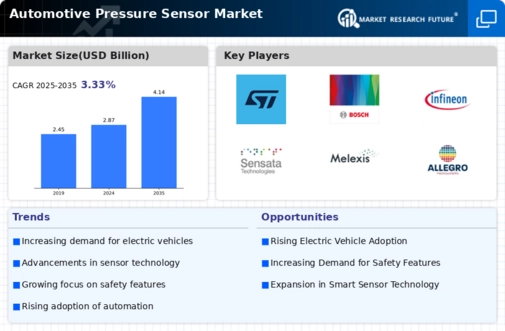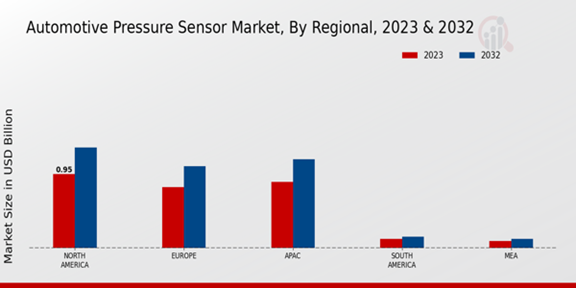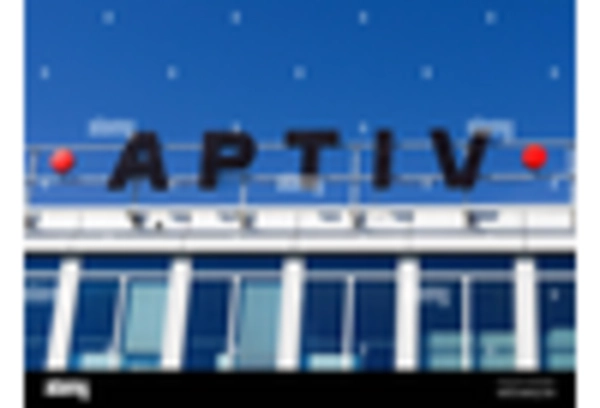Emerging Markets and Urbanization
The Automotive Pressure Sensor Market is also influenced by emerging markets and urbanization trends. As urban populations grow, there is an increasing demand for vehicles that meet the needs of densely populated areas. This demand drives the necessity for efficient automotive technologies, including pressure sensors. Emerging markets are witnessing a rise in vehicle ownership, which correlates with a growing need for advanced automotive components. Market forecasts suggest that these regions will experience substantial growth in automotive sales, thereby positively impacting the Automotive Pressure Sensor Market. This trend highlights the potential for manufacturers to expand their reach and develop products tailored to the unique requirements of these markets.
Growth of the Automotive Aftermarket
The Automotive Pressure Sensor Market is benefiting from the growth of the automotive aftermarket. As vehicles age, the need for replacement parts, including pressure sensors, becomes more pronounced. The aftermarket segment is projected to expand, driven by an increasing number of vehicles on the road and a growing emphasis on vehicle maintenance. This trend is particularly relevant as older vehicles often require upgraded or replacement pressure sensors to maintain optimal performance. Market data indicates that the aftermarket for automotive components is likely to see significant growth, which will, in turn, bolster the Automotive Pressure Sensor Market. This dynamic presents opportunities for manufacturers to innovate and cater to the evolving needs of consumers.
Rising Demand for Electric Vehicles (EVs)
The Automotive Pressure Sensor Market is poised for growth due to the rising demand for electric vehicles (EVs). As manufacturers shift towards electrification, the need for efficient pressure sensors in battery management systems and tire pressure monitoring systems becomes increasingly critical. Data suggests that the EV market is expected to expand rapidly, with projections indicating that EV sales could reach unprecedented levels in the coming years. This shift necessitates the integration of advanced pressure sensors to ensure optimal performance and safety in electric vehicles. Consequently, the Automotive Pressure Sensor Market is likely to benefit from this transition, as manufacturers seek to enhance the reliability and efficiency of their electric offerings.
Increased Focus on Vehicle Safety Features
The Automotive Pressure Sensor Market is significantly influenced by the heightened focus on vehicle safety features. As consumers become more safety-conscious, manufacturers are compelled to integrate advanced safety technologies into their vehicles. Pressure sensors play a crucial role in various safety systems, including tire pressure monitoring and engine management. Regulatory bodies are also imposing stricter safety standards, which further drives the demand for reliable pressure sensors. Market analysis indicates that the automotive safety systems market is expected to grow substantially, thereby positively impacting the Automotive Pressure Sensor Market. This trend underscores the importance of pressure sensors in enhancing overall vehicle safety and performance.
Technological Advancements in Automotive Pressure Sensors
The Automotive Pressure Sensor Market is experiencing a surge in technological advancements, particularly with the integration of smart sensors. These sensors are designed to provide real-time data, enhancing vehicle performance and safety. The introduction of MEMS (Micro-Electro-Mechanical Systems) technology has revolutionized pressure sensing, allowing for smaller, more efficient devices. As vehicles become increasingly reliant on electronic systems, the demand for high-precision pressure sensors is expected to rise. Reports indicate that the market for MEMS pressure sensors alone is projected to grow significantly, reflecting a broader trend within the Automotive Pressure Sensor Market. This evolution not only improves vehicle efficiency but also aligns with the growing consumer demand for advanced automotive technologies.


















Leave a Comment